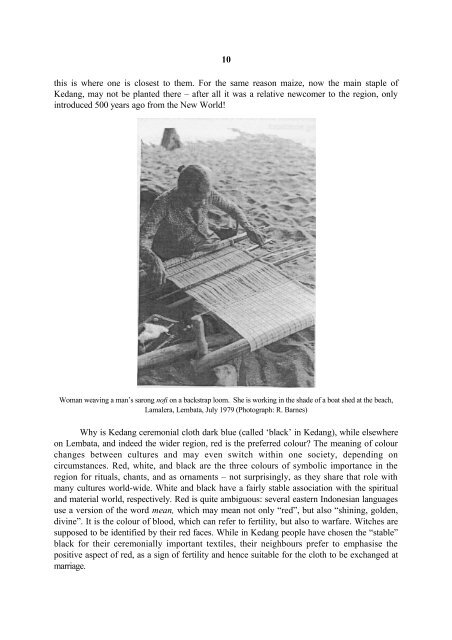download - OATG. Oxford Asian Textile Group
download - OATG. Oxford Asian Textile Group
download - OATG. Oxford Asian Textile Group
Create successful ePaper yourself
Turn your PDF publications into a flip-book with our unique Google optimized e-Paper software.
10<br />
this is where one is closest to them. For the same reason maize, now the main staple of<br />
Kedang, may not be planted there – after all it was a relative newcomer to the region, only<br />
introduced 500 years ago from the New World!<br />
Woman weaving a man’s sarong nofi on a backstrap loom. She is working in the shade of a boat shed at the beach,<br />
Lamalera, Lembata, July 1979 (Photograph: R. Barnes)<br />
Why is Kedang ceremonial cloth dark blue (called ‘black’ in Kedang), while elsewhere<br />
on Lembata, and indeed the wider region, red is the preferred colour The meaning of colour<br />
changes between cultures and may even switch within one society, depending on<br />
circumstances. Red, white, and black are the three colours of symbolic importance in the<br />
region for rituals, chants, and as ornaments – not surprisingly, as they share that role with<br />
many cultures world-wide. White and black have a fairly stable association with the spiritual<br />
and material world, respectively. Red is quite ambiguous: several eastern Indonesian languages<br />
use a version of the word mean, which may mean not only “red”, but also “shining, golden,<br />
divine”. It is the colour of blood, which can refer to fertility, but also to warfare. Witches are<br />
supposed to be identified by their red faces. While in Kedang people have chosen the “stable”<br />
black for their ceremonially important textiles, their neighbours prefer to emphasise the<br />
positive aspect of red, as a sign of fertility and hence suitable for the cloth to be exchanged at<br />
marriage.
















